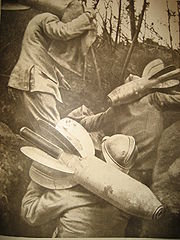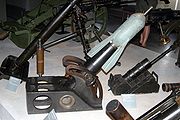
Mortier de 58 mm type 2
Encyclopedia
The Mortier de 58 mm type 2, also known as the Crapouillot or "little toad" from its appearance, was the standard French medium trench mortar of World War I
.

 3 types of bomb were available :
3 types of bomb were available :
Examples of capabilities :-
World War I
World War I , which was predominantly called the World War or the Great War from its occurrence until 1939, and the First World War or World War I thereafter, was a major war centred in Europe that began on 28 July 1914 and lasted until 11 November 1918...
.
Combat use


- Light L.S. bomb - 18 kg, containing 5.35 kg explosive. 6 wings, hollow plugged tail.
- Heavy D.L.S. bomb - 35 kg, containing 10.0 kg explosive. 6 wings, hollow plugged tail.
- Medium A.L.S bomb - 20 kg, containing 6.4 kg explosive. 3 wings, unlike the other 2 it has a hollow tail which contained the propellant charge, placing thrust closer to center of gravity and increasing range and accuracy. Not yet in common use as at March 1918.
Examples of capabilities :-
- To destroy a 3m x 3m blockhouse, 60-80 D.L.S. bombs or 100-150 L.S. bombs were required.
- To cut a passage through barbed wire defences 40mtr wide x 30mtr deep, 120 D.L.S. bombs or 200 L.S. bombs were required.
See also
- MortarMortar (weapon)A mortar is an indirect fire weapon that fires explosive projectiles known as bombs at low velocities, short ranges, and high-arcing ballistic trajectories. It is typically muzzle-loading and has a barrel length less than 15 times its caliber....
- 2 inch Medium Mortar2 inch Medium MortarThe 2 inch Medium Trench Mortar, also known as the 2-inch Howitzer, and nicknamed the "Toffee Apple" or "Plum Pudding" mortar, was a British SBML medium trench mortar in use in World War I from mid 1915 to mid 1917...
Early British equivalent - Newton 6 inch MortarNewton 6 inch MortarThe Newton 6 inch Mortar was the standard British medium mortar in World War I from early 1917 onwards.-Description:The Newton 6 inch replaced the 2 inch Medium Mortar beginning in February 1917....
Later British equivalent - List of heavy mortars
Surviving examples
- Many places around France, especially as war memorials.
- At the Polish Army MuseumPolish Army Museum-Newest Exhibition:The Polish Army Museum was not too long ago given the equipment of the lost soldiers from the Presidential Smolensk aircraft crash. The equipment includes the ID Passes, Portable radios, torches, holsters and much more and all in their original state.Museum of the Polish Army is...
in Warsaw. - Passion & Compassion 1914-1918. French Artillery - photographs of surviving examples

